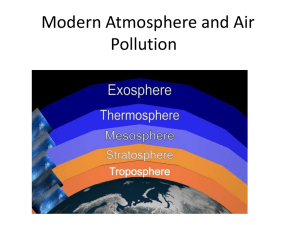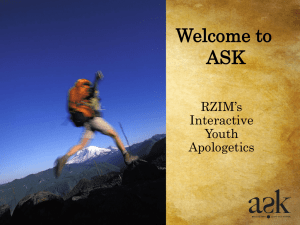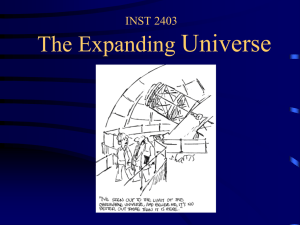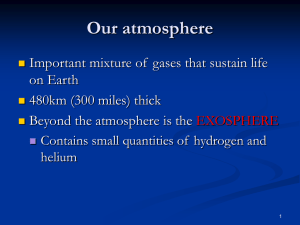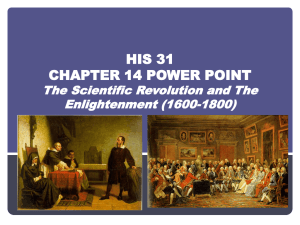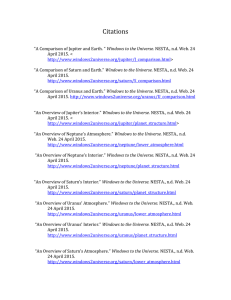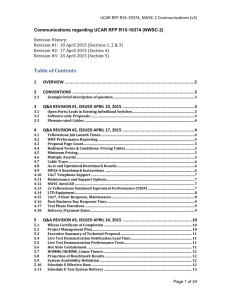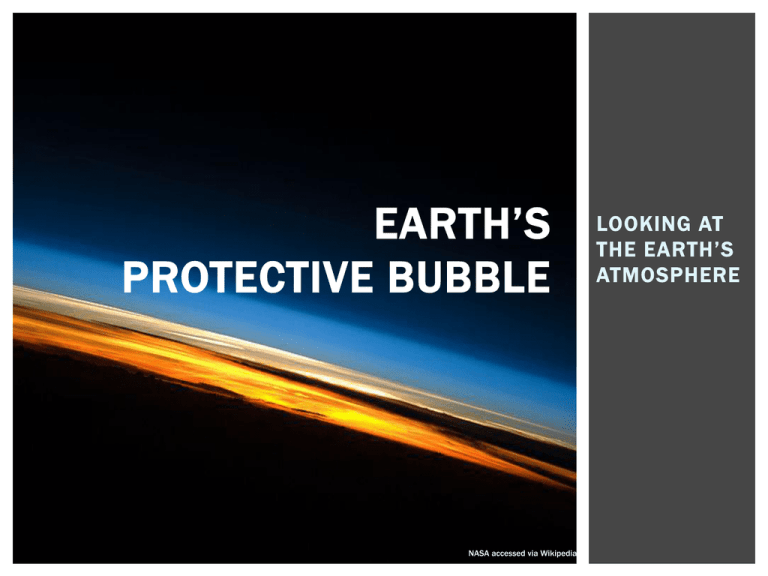
EARTH’S
PROTECTIVE BUBBLE
NASA accessed via Wikipedia
LOOKING AT
THE EARTH’S
ATMOSPHERE
WHAT’S SO SPECIAL?
Earth is surrounded by a blanket of air called the atmosphere
Extends near or over 600 kilometers from Earth’s surface
Held by Earth’s gravitational pull
Composed of many different gases
Separated into several different layers
Protects us from outer space
Blocks out dangerous rays (UV) from the sun
Quite transparent to visible light
Ionosphere
Heterosphere
_ _ _ _ _ _ _ _ _ _ _ _ _ _ _ _ _ _ _ _ _ _
_ _ _ _ _ _ _ _ _ _ _ _ _ _ _ _ _ _ _ _ _ _
Homosphere
A PROFILE OF THE
ATMOSPHERE
REVEALS IT CAN
BE DIVIDED INTO
DISTINCT LAYERS
EACH LAYER CAN
BE DEFINED BY
THE GASES THAT
COMPRISES IT OR
TEMPERATURE
VARIATION OR
ELECTRICAL
PROPERTIES
SEPARATING THE
LAYERS IS A
BOUNDARY OR
“PAUSE” WHERE
THE GREATEST
CHANGES
PROPERTIES
OCCUR
The source of this material is Windows to the Universe, at http://www.windows2universe.org http://www.windows.ucar.edu/ at the National Earth Science Teachers Association (NESTA) <http://www.ucar.edu>. Windows to the Universe® is a registered trademark. All Rights Reserved
MIXING IT UP
Homosphere
Heterosphere
l o w e r a t m o sph e r e
u p p e r a t m o s ph e r e
The air we breathe is very
well mixed
The air is comprised of
78%: Nitrogen (N2)
21%: Oxygen (O2)
other 1%: “trace” gases
Argon (Ar)
Carbon Dioxide (CO2)
Ozone (O3)
Water (H2O)
… and more
Wikipedia | Public Domain
The air in the upper
atmosphere is very dif ferent
from the air we breathe
The air is not well mixed
Atoms get sorted by atomic
weight
Hydrogen and Helium can
sometimes escape gravity
Troposphere
Sur face ~ 15km
THE LOWER ATMOSPHERE
THE WEATHER ZONE
ALMOST ALL WEATHER OCCURS IN THIS LAYER
HEIGHT OF THE TROPOSPHERE VARIES FROM THE
EQUATOR (15KM) TO THE POLES (9KM)
TRANSPORT OF ENERGY HEATS THIS LAYER
AS YOU GO UP … (INCREASE IN ALTITUDE)
PRESSURE DECREASES
DENSIT Y OF GASES DECREASES
TEMPERATURE DECREASES UNIFORMLY
A TRANSITION ZONE KNOWN AS THE TROPOPAUSE
IS THE BOUNDARY BET WEEN THE TROPOSPHERE
AND STRATOSPHERE … ALL DRY (ALMOST)!
Kathryn Haughn
The source of this material is Windows to the Universe, at http://www.windows2universe.org http://www.windows.ucar.edu/ at the National Earth Science Teachers Association (NESTA) <http://www.ucar.edu>. Windows to the Universe® is a registered trademark. All Rights Reserved
Stratosphere
STABLE LAYER (IDEAL FOR JET PLANES
15km ~ 50km
OZONE LAYER IS IN THIS LAYER
LET IT LINGER (CFC’S, VOLCANIC ASH, AEROSOLS)
WEATHER BALLOONS
AS YOU GO UP …
PRESSURE DECREASES
AIR IS DRY AND LESS DENSE
TEMPERATURE INCREASES ( -52°C ~ -3°C)
99% OF THE ATMOSPHERE IS LOCATED IN THE
TROPOSPHERE AND STRATOSPHERE!
A TRANSITION ZONE KNOWN AS THE STRATOPAUSE
IS THE BOUNDARY BET WEEN THE STRATOSPHERE
AND MESOSPHERE … WHAT PRESSURE?
NASA
The source of this material is Windows to the Universe, at http://www.windows2universe.org http://www.windows.ucar.edu/ at the National Earth Science Teachers Association (NESTA) <http://www.ucar.edu>. Windows to the Universe® is a registered trademark. All Rights Reserved
Mesosphere
50KM ~ 85 KM
THE COLD LAYER
NOCTILUCENT CLOUDS
METEORS BURN UP IN THIS LAYER
NOT EASY TO STUDY
AS YOU GO UP …
PRESSURE DECREASES
DENSIT Y OF GASES CONTINUES TO DECREASE
TEMPERATURE DECREASES ( -3°C ~ -90°C)
A TRANSITION ZONE KNOWN AS THE MESOPAUSE IS
THE BOUNDARY BET WEEN THE MESOSPHERE AND
THERMOSPHERE … COLDEST PLACE ON EARTH!
NASA
The source of this material is Windows to the Universe, at http://www.windows2universe.org http://www.windows.ucar.edu/ at the National Earth Science Teachers Association (NESTA) <http://www.ucar.edu>. Windows to the Universe® is a registered trademark. All Rights Reserved
THE UPPER ATMOSPHERE
Thermosphere
85km ~ 600km
HOT! HOT! HOT!
NOT MUCH AROUND (MOLECULES THAT IS)
X-RAY AND UV RADIATION ABSORBED
SPACE SHUTTLES AND INTERNATIONAL SPACE
STATION ORBIT IN THIS LAYER
SENSITIVE TO SOLAR ACTIVIT Y
AURORA
OVERLAPS AND SHARES SPACE WITH IONOSPHERE
AS YOU GO UP …
PRESSURE DECREASES
DENSIT Y OF MOLECULES IS EXTREMELY
LOW TEMPERATURE INCREASES (-90°C ~ 2000°C)
NASA
The source of this material is Windows to the Universe, at http://www.windows2universe.org http://www.windows.ucar.edu/ at the National Earth Science Teachers Association (NESTA) <http://www.ucar.edu>. Windows to the Universe® is a registered trademark. All Rights Reserved
Exosphere
600+ km
THE ESCAPE ZONE
EXTENDS UNTIL IT MERGES WITH SPACE
UPPER LIMIT OF OUR ATMOSPHERE
COMPRISED OF MAINLY HYDROGEN AND
HELIUM
SATELLITES ORBIT EARTH IN THIS LAYER
NASA
The source of this material is Windows to the Universe, at http://www.windows2universe.org http://www.windows.ucar.edu/ at the National Earth Science Teachers Association (NESTA) <http://www.ucar.edu>. Windows to the Universe® is a registered trademark. All Rights Reserved
THE
ELECTRIFIED
REGION
SHOWS YET
ANOTHER WAY
LAYERS OF
THE
ATMOSPHERE
CAN BE
DEFINED
Windows to the Universe® (http://windows2universe.org) © 2010, National Earth Science Teachers Association.
IONOSPHERE
( 6 0 KM – TOP OF AT MOSPH ERE )
AN ELECTRIF IED REGION (NOT REALLY A
LAYER ITSELF) WITHIN THE UPPER
ATMOSPHERE
EXISTE NCE IS DUE TO THE SUN’S RADITATION
THE DENSIT Y CHANGES FROM DAY TIM E TO
NIGHTTIM E
AM RADIO COMMUNICATION RELIES ON THE
IONOSPHERE
CONSISTS OF IONS AND FREE ELECTRONS
IONS ARE ATOMS AND MOLECULES THAT HAVE LOST OR
GAINED ELECTRON(S)
MIT Haystack
STARTS AT ABOUT 60KM AND EXTENDS
TO THE TOP OF THE ATMOSPHERE
DIVIDED INTO 3 LAYERS;
THE D, E, AND F LAYERS
NOAA
THE D LAYER
LOWEST LAYER
ABSORBS GAMMA
AND X-RAYS
REFLECTS AM RADIO
WAVES BACK TO EARTH
AT NIGHT THE LAYER
DISAPPEARS
(GRADUALLY) AT NIGHT
WHAT HAPPENS TO THE
AM RADIO WAVES THEN?
NOAA
MORE ON THE IONOSPHERE
THE E LAYER
PEAKS AT 105KM
ABSORBS X-RAYS
THE F LAYER
MIT Haystack
HIGHEST LAYER
UP TO 600KM or MORE
ABSORBS EXTREME UV
Kathryn Haughn
Credit: John Emmert/NRL


